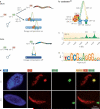Condensin and cohesin complexity: the expanding repertoire of functions
- PMID: 20442714
- PMCID: PMC3491780
- DOI: 10.1038/nrg2794
Condensin and cohesin complexity: the expanding repertoire of functions
Abstract
Condensin and cohesin complexes act in diverse nuclear processes in addition to their widely known roles in chromosome compaction and sister chromatid cohesion. Recent work has elucidated the contribution of condensin and cohesin to interphase genome organization, control of gene expression, metazoan development and meiosis. Despite these wide-ranging functions, several themes have come to light: both complexes establish higher-order chromosome structure by inhibiting or promoting interactions between distant genomic regions, both complexes influence the chromosomal association of other proteins, and both complexes achieve functional specialization by swapping homologous subunits. Emerging data are expanding the range of processes in which condensin and cohesin are known to participate and are enhancing our knowledge of how chromosome architecture is regulated to influence numerous cellular functions.
Figures


References
-
- De Piccoli G, Torres-Rosell J, Aragon L. The unnamed complex: what do we know about Smc5–Smc6? Chromosome Res. 2009;17:251–263. - PubMed
-
- Nasmyth K, Haering CH. Cohesin: its roles and mechanisms. Annu. Rev. Genet. 2009;43:525–558. - PubMed
-
- Hudson DF, Marshall KM, Earnshaw WC. Condensin: architect of mitotic chromosomes. Chromosome Res. 2009;17:131–144. - PubMed
-
- Hirano T. At the heart of the chromosome: SMC proteins in action. Nature Rev. Mol. Cell Biol. 2006;7:311–322. - PubMed
-
- Parelho V, et al. Cohesins functionally associate with CTCF on mammalian chromosome arms. Cell. 2008;132:422–433. - PubMed
Publication types
MeSH terms
Substances
Grants and funding
LinkOut - more resources
Full Text Sources

